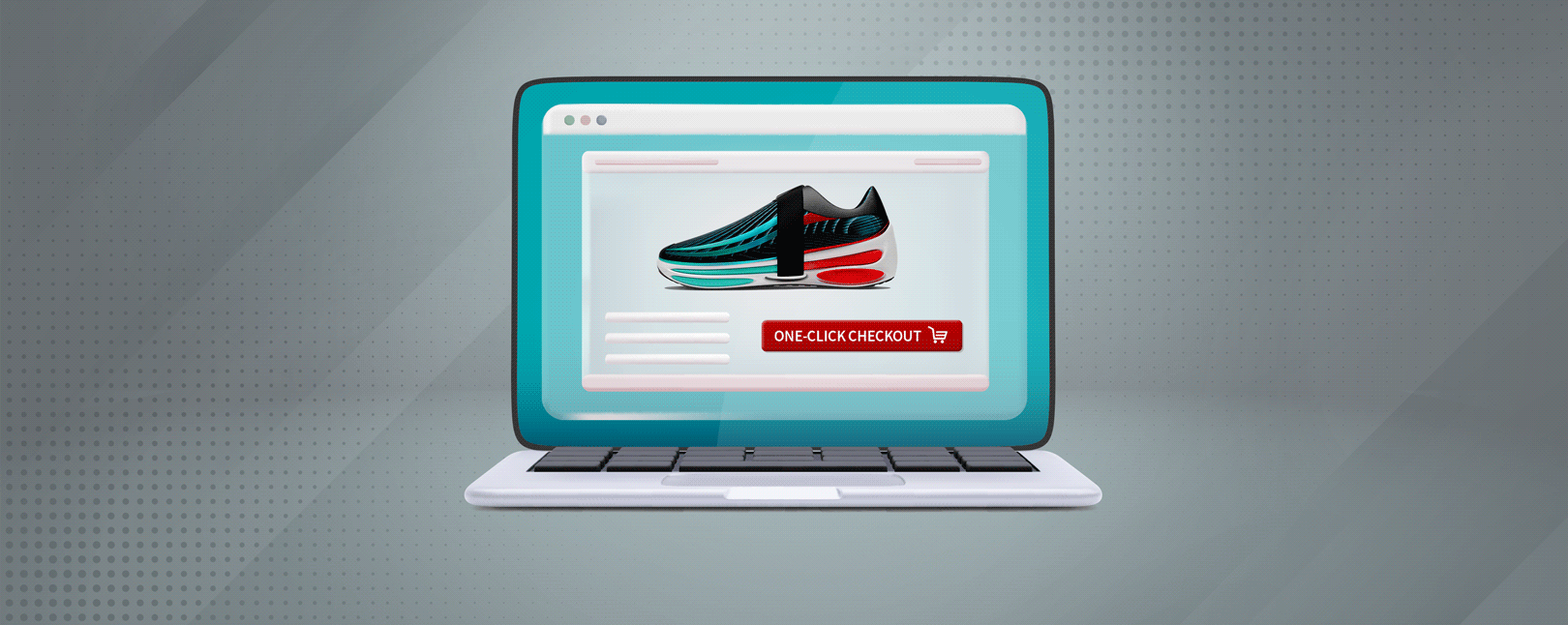One-Click Checkout: Fast & Smooth Interactions May Come at a Price
Have you ever tested the checkout process out on your own site?
When you do this, you need to approach it from your customer’s perspective. As a buyer, you’re just trying to get the goods you want. Every extra field you need to fill out is a barrier; a potential jumping-off point. It’s worse if you have to go through the same process every time they revisit your site.
Consumers are being drawn to one-click checkout whenever they shop online. If you haven’t gotten on board yet, it may be time to reexamine your overall customer experience. In this post, we explore the specifics of one-click checkout, including how it works, how you can get it, and whether it’s a good fit for all merchants.
Recommended reading
- What is Alipay? Can US Consumers & Merchants Use Alipay?
- Apple Pay: Fast, Secure, & Private… but is There a Catch?
- Terminal ID Number (TID): What is it? What Does it Do?
- The Top 10 Online Payment Processing Providers of 2024
- Is Open Banking Equipped to Fight Fraud?
- Google Pay: How to Sep Up & Accept Payments Using the App
What is One-Click Checkout?
- One-Click Checkout
One-click checkout is a practice that may be implemented as part of the eCommerce checkout process. It lets users set default payment credentials and shipping information to make future purchases with the click of a single button.
[noun]/Wən • klik • CHek • out/Essentially, one-click is an “express lane” through the typical online checkout procedure. As the name implies, customers can complete a transaction with just a single mouse click or finger tap. The system auto-fills the cardholder’s personal information by accessing data that was entered and used for a previous purchase.
One-click checkout was originally introduced by Amazon. At the time, the process was such a novel concept that the online giant was able to patent it for internal use. That patent expired in 2017, which is good news for both merchants and consumers.
One-click payments are a win-win. Customers get a streamlined process, while you benefit from higher conversion, less cart abandonment, and greater long-term customer value.
How Does One-Click Checkout Work?
Before one-click shopping can take place, a shopper must go through the traditional checkout process at least once. The buyer enters all the necessary personal data (name, shipping and billing addresses, contact information, etc.) as well as payment card details such as card number, CVV, and expiration date.
All that data is captured, tokenized, and stored on the merchant’s secure server. When the customer revisits the site, they have the option of paying with a simple click from any product page or cart, bypassing checkout entirely. Customers have a designated time period to edit or cancel before the purchase is automatically authorized and processed.
The merchant may choose to include an additional confirmation page. Also, payment methods like PayPal may require the buyer to enter information through a pop-up window. In other words, “one-click” isn’t always a literal description, but the spirit is the same.
Even with these additional steps, though, the purchase process is much faster and easier than traditional eCommerce. Friction is removed, making it easier for buyers to complete transactions. They’re more inclined to make future purchases with you as a result.
Does One-Click Checkout Benefit Merchants?
For users, the most direct perk of one-click checkout is convenience. But that benefit comes back to the merchant in different ways:

Using One-Click Payments Methods in Mobile Channels
Still unsure about adding a fast one-click checkout to your operations? It’s important to remember that modern consumers browse through mobile devices more than desktop machines.
mCommerce is gradually becoming the dominant digital sales channel. These mobile-first online buyers are simply not willing to repeatedly slog through an intensive checkout process.
Smaller screens make it even harder to enter contact and payment details. In fact, checkout completion rates can be 10 percent higher on desktop machines compared to mobile transactions. A poor mobile checkout experience appears to be one of the most common causes for order abandonment.
One-click checkout benefits are amplified on mobile. With no forms or fields to fill, customers can easily buy from anywhere. The smaller screen means fewer distractions that might lower conversions. Also, tokenized data transfers make leaky public wifi less of an issue.
Is One-Click Checkout Right for Me?
So, should you implement one-click checkout for your business? There isn’t a single, universal answer to that question.
One-click offers lots of advantages, but it’s not the best choice for everyone. The benefits can vary according to the merchant, the items sold, and other factors. So, before you invest in one-click payments, ask yourself a few questions:
Only you can decide if one-click checkout will work for your business. Taking these factors into consideration can help project your potential return on investment, and give you a better impression of whether it’s worthwhile.
How to Offer One-click Checkout to Customers
So you’ve read this far and decided that “one-click” might be a good payment option for your online store. Now what? How do you get it on your site? Here are a few steps to get you started.
Consider your needs
Obviously, there’s no point in going with a provider that doesn’t offer all the features you need. Certain features you should look for before signing include:
Compare providers
Once you have a better understanding of your needs, look at what the various providers have to offer. Some of the top providers include:

Amazon Pay
Amazon invented one-click checkout and has been refining and perfecting their payments technologies for decades. The brand also gives you widespread name recognition.
Bolt
Bolt’s solution is easily integrated into most eCommerce platforms. According to reviews, however, the product’s reporting capabilities could stand to be more flexible.
PayPal One Touch
One Touch for PayPal provides a one-click payment method. It only works for sites accepting PayPal, but offers an established and trusted brand.
Shopify Shop Pay
You don’t need a Shopify store to use the Shop Pay one-click payment solution. It works with multiple platforms like Facebook, Google, or an online store.
This is just a sample–there are many more options available. Also, while most eCommerce platforms (Magento, Squarespace, WooCommerce, etc.) can work with third-party providers, they also feature their own version of one-click checkout.
Click-to-Pay enables single-click purchasing at any participating online store. It allows the cardholder to store all their Visa, Mastercard, American Express, and Discover card information in one place for a uniform payment experience.
Install
Either your platform provider or your one-click vendor should have instructions for marrying the two systems. You may require technical support, or it may be as basic as adding an app or plug-in.
What About Fraud?
One other thing to consider when looking at adding single-click checkout: fraud.
As we mentioned earlier, the tokenization built into one-click options will protect data in transit. The real threat will probably not come from criminals, though. Instead, you’re more likely to see friendly fraud become an issue.
Friction in the checkout process is never really welcome. However, it can provide some benefit, in that it forces shoppers to slow down and really consider a purchase before hitting “submit.” The easier it is to make an impulse buy, the greater the chances of buyer’s remorse. This often leads to chargebacks.
Some providers offer chargeback fraud protection to help limit friendly fraud losses. However, the extent of this coverage will vary and may require extra costs. In either case, you’re not necessarily addressing the underlying problem, which is the initial buyer’s remorse itself.

The Bottom Line
Whether you’re looking to build repeat business, decrease cart abandonment, or drive impulse purchases, offering one-click buying as a payment option can be a great way of enhancing the customer experience. By streamlining payments and upgrading customer data security, merchants can optimize the buyer journey.
That said, sales strategies aren’t a one-size-fits-all solution. Some types of businesses, including those dealing in high-cost, single-purchase goods, may not benefit enough from one-click to make it worth the cost of implementing.
And while one-click offers efficiency, convenience, and ease of use, it can’t protect merchants from friendly fraud. In some ways, it may even increase the threat.
If your business is feeling the pinch from fraud and chargeback issues, we have the most complete end-to-end solution available. To learn more, contact us today.
FAQs
What is one-click payment?
One-click checkout is a practice that may be implemented as part of the eCommerce checkout process. It lets users set default payment credentials and shipping information to make future purchases with the click of a single button.
How does one-click checkout work?
Buttons for the one–click option appear on product pages and in other locations on the site. Instead of manually entering billing, shipping, and card information, signed-in customers can choose to click on the button to complete the purchase using predefined information the retailer has on file.
Is one-click payment safe?
Most one-click payment providers offer “bank-level” security, including PCI DSS compliance. In addition, all card information is tokenized: sensitive customer data is substituted with a one-time alphanumeric ID that has no value or connection to the account's owner.
How does one-click checkout benefit buyers?
Customers get a streamlined checkout process that is faster, easier, and more convenient.
How does one-click checkout benefit merchants?
Merchants benefit from decreased cart abandonment, more repeat business and impulse buys, and an overall better experience for their customers. Merchants need to be careful, though; chargebacks resulting from buyer’s remorse could offset these benefits.













